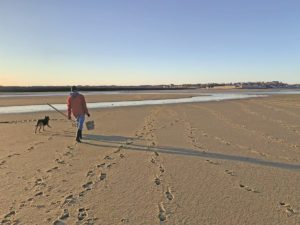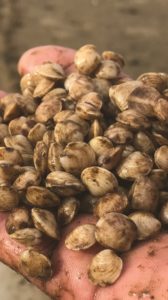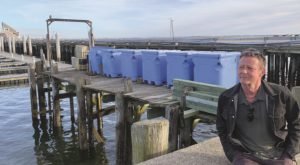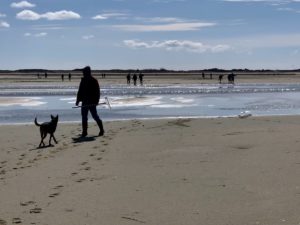PROVINCETOWN — Last Nov. 14, a Sunday, a record was set here: 200 people went clamming on one day.
“Never have 200 people gotten together and dug clams in Provincetown in all its history,” Shellfish Constable Steve Wisbauer told the Independent. “This is new to us.”
Provincetown was already unique on Cape Cod in that it devotes its entire wild shellfish resource to recreation. The town’s regulations technically cover three species of clam plus wild-caught oysters, but in Provincetown shellfish lovers overwhelmingly go after the small hard-shelled quahogs that are dug up with rakes, tossed in baskets, and carried home for dinner.

In a normal year, the season runs from the first weekend of November to the last weekend of March. In the pandemic years of 2020 and 2021, the season was extended through the month of April. Clamming grew explosively in those years, as the breezy salt flats became a safe place to get some exercise, chat with neighbors, and dig up a cheap meal.
“I’ve heard old-timers on the Cape refer to a ‘quahog winter,’ meaning a winter where things were a little lean financially and people really needed that protein,” said Abigail Archer, a fisheries and aquaculture specialist with Barnstable County’s Cooperative Extension. “We saw more people getting licenses, people going out more days, and people absolutely harvesting to their limit” during the two pandemic winters, Archer said.
“It was nice to have that extra month of April these last two years,” said Marc Guerrette, a dedicated clammer who digs almost every winter weekend. Guerrette cooks his clams into pastas, pizzas, and even lasagnas. The last dig of the season is bittersweet, he said, as it’s a long wait until November.
Even with the recent surge in shellfishing popularity, Provincetown’s tidal flats could support much more recreational clamming, Wisbauer said. The season could even be year-round.
“Some areas can’t be opened in the summer, but most of our areas could,” said Wisbauer. “It’s a choice.
“It would be a whole different game with the summer population, because the town goes from a few thousand people to 60,000 people,” Wisbauer added. “The town has chosen to approach it this way. We could choose to approach it another way. It’s not my role to say — but I can describe the process.”
A year-round season has never been on the shellfish committee’s agenda, Wisbauer said, but any member of the public could ask for it to be considered. There are many issues at play, especially related to education, enforcement, and food safety. The shellfish committee would debate them and could forward a recommendation to the select board.
But the actual supply of clams is not a limiting factor. “The resource, through this method of propagation, has exploded,” said Wisbauer. “We’ve got plenty of it.”

Even people who dig clams may not be aware that the flats are seeded with nursery-grown animals. Half a million baby quahogs, each about the size of a Skittle candy, will be delivered to Provincetown this October. Wisbauer and a group of volunteers will hand-cast them into the town’s clamming areas by boat.
Another 300,000 even smaller “seed” animals from the county’s joint purchasing program will be maturing in tanks on Bennett Pier starting in July and will also be cast around October. These animals are so tiny when they arrive that they look like a Ziploc bag full of semolina grains, said Wisbauer.
The Skittle-size quahogs take about 18 months to mature in the wild, Wisbauer said, and have a survival rate of over 90 percent. They cost the town around $10,000.

“We could bump this half-million as high as we want,” said Wisbauer. “It’s scalable.”
Clams can move around in the sandy flats of the harbor — and Provincetown’s clams have been congregating on both sides of the breakwater, about three-quarters of a mile out. This is a good thing, as far as Wisbauer is concerned: it’s mostly experienced and well-informed people who venture that far out, and the access point from the Pilgrims’ First Landing Park out to the breakwater is relatively easy to supervise.
“This is a three-pronged job,” said Wisbauer, “protecting the environment, protecting the animal resource, but, most important, protecting human safety. The origin story of the shellfish constable is to try and prevent food poisoning. Shellfish and raw milk have their own laws because people were dying.”
The principal challenge of a year-long shellfish season might be ensuring that summer people know how to handle, store, and cook their findings.

“We could issue weekly permits,” Wisbauer said. “People could dig their own dinner. But I don’t know that the town wants that.”
The Cooperative Extension is currently trying to measure the economic effect of recreational shellfishing on Cape Cod, Archer said.
“Anyone who’s gone out and done it, you know the dollar value to yourself,” said Archer, “but sometimes you need an actual dollar number to convey that value to funding agencies.”
The survey is at seagrant.whoi.edu/recreational-shellfishing-survey and has questions about how far you travel, and how much you spend, to go clamming.
For people who live here, the latter number is delightfully small: a seasonal permit is only $15 (free for seniors), and a good clamming rake is about $60. Permit holders can take one peck of clams per week, which is enough to make two family dinners.
Clamming might catch an even wider audience if it were a warm-weather activity. It’s not the abundance of clams that’s the challenge these days — it’s the abundance of potential clammers.



